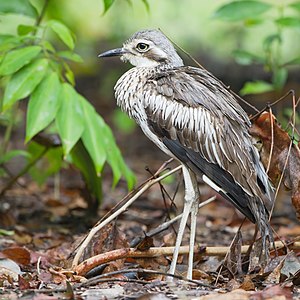Bush stone curlew
| Bush stone-curlew | |
|---|---|
 |
|
| In Cairns, Australia | |
| Scientific classification | |
| Kingdom: | Animalia |
| Phylum: | Chordata |
| Class: | Aves |
| Order: | Charadriiformes |
| Family: | Burhinidae |
| Genus: | Burhinus |
| Species: | B. grallarius |
| Binomial name | |
|
Burhinus grallarius (Latham, 1801) |
|
The bush stone-curlew or bush thick-knee (Burhinus grallarius, obsolete name Burhinus magnirostris) is a large (55–60 cm wingspan), ground-dwelling bird endemic to Australia.
The bush stone-curlew was first described by the English ornithologist John Latham in 1801 under the binomial name Charadius grallarius.
Like most stone-curlews, it is mainly nocturnal and specialises in hunting small grassland animals: frogs, spiders, insects, molluscs, crustaceans, snakes, lizards and small mammals are all taken, mostly gleaned or probed from soft soil or rotting wood; also a few seeds or tubers, particularly in drought years. Birds usually forage individually or in pairs over a large home range, particularly on moonlit nights.
During the day, bush stone-curlews tend to remain inactive, sheltering amongst tall grass or low shrubs and relying on their cryptic plumage to protect them from predators. When disturbed, they freeze motionless, often in odd-looking postures. For visual predators like raptors (and humans), this works well, but it serves little purpose with animals that hunt by scent such as foxes, dingoes or goannas.
Despite their ungainly appearance and habit of freezing motionless, they are sure-footed, fast and agile on the ground, and although they seldom fly during daylight hours, they are far from clumsy in the air; flight is rapid and direct on long, broad wings.
The bush Stone-curlew is probably heard more than it is seen. Its call sounds like a wail or a scream in the night. When scared, it screeches – a sound similar to the screech of a possum. When threatened (presumably in the presence of a nest), they may raise their wings wide and high in an impressive threat posture and emit a loud, hoarse hissing noise.
The bush stone-curlew has a broad habitat preference, it can be found in open forest, eucalyptus woodland, rainforest edges, grassy plains, arid scrubland and along inland watercourses. It is a common species in the cities of Brisbane, Cairns and Townsville however is not found in urban areas in the south of its range. It can be found throughout Australia apart from the West Australian coast and Tasmania. It is still abundant in the tropical and sub-tropical north, however has become very rare in the less fertile south where it was once common.
...
Wikipedia

